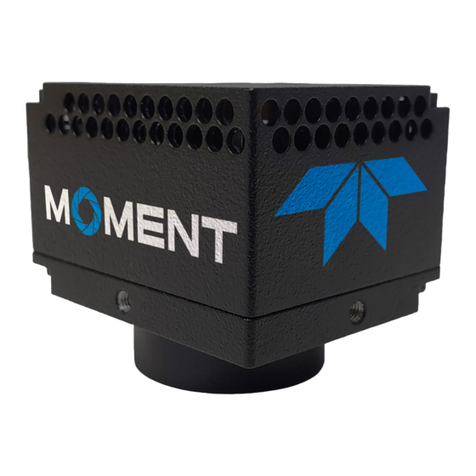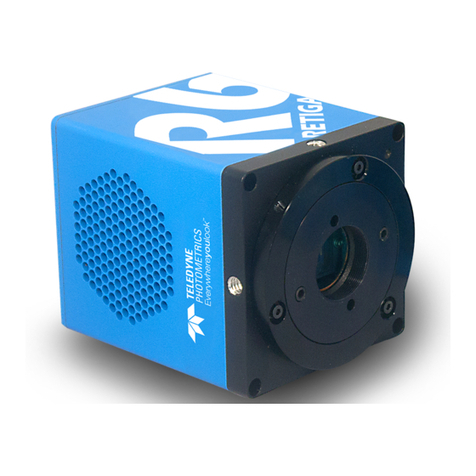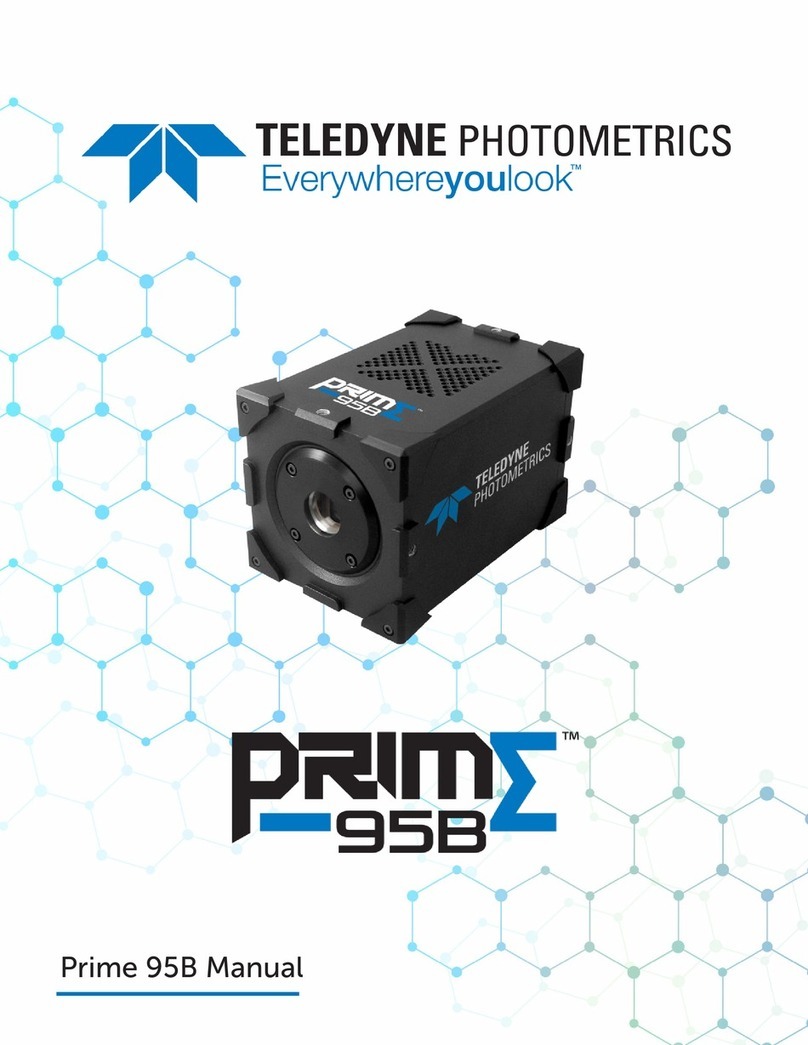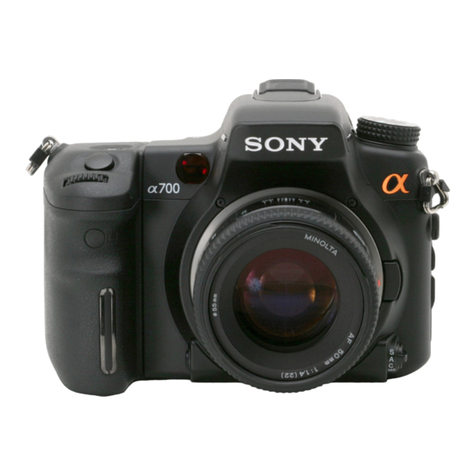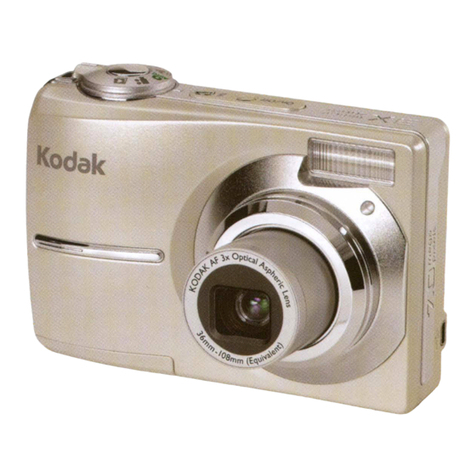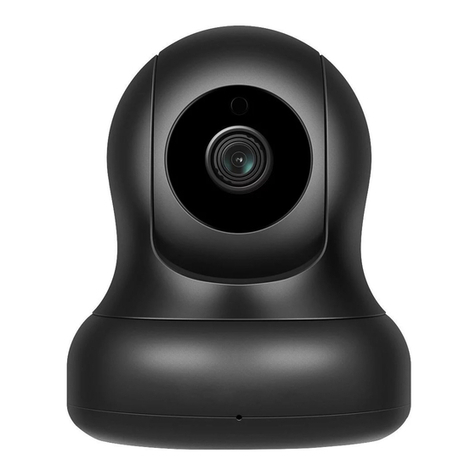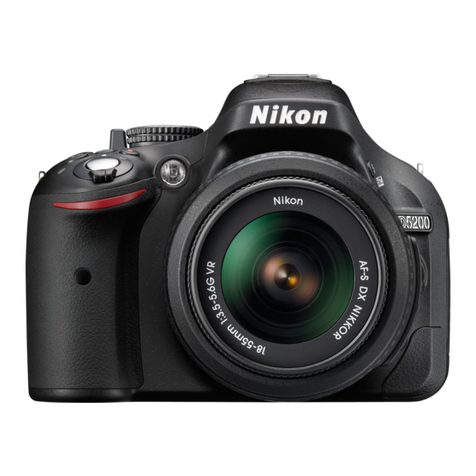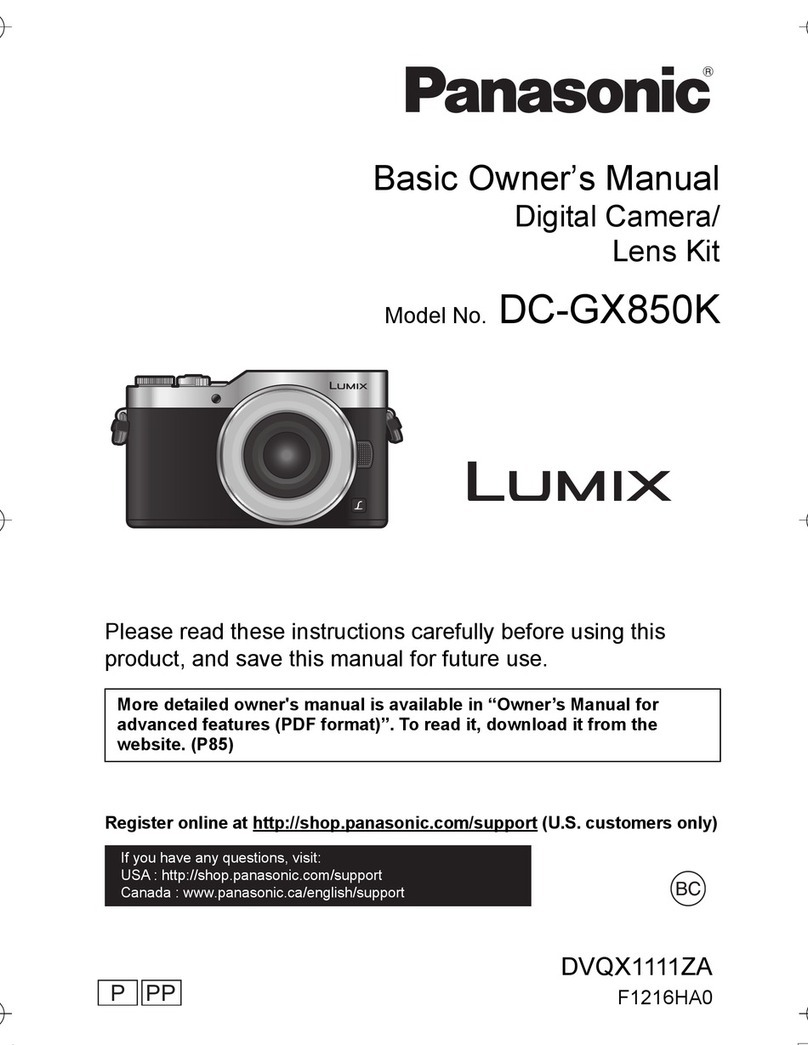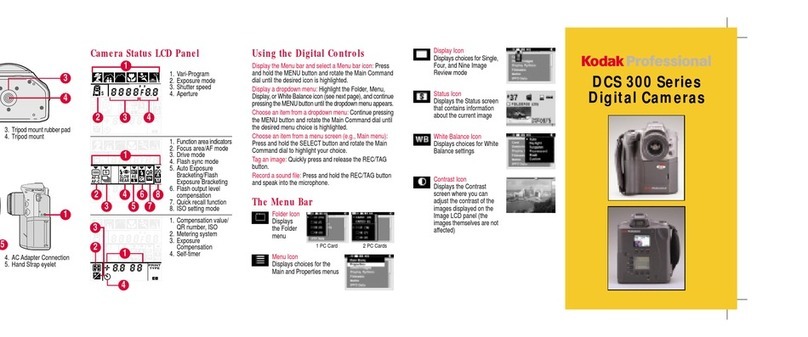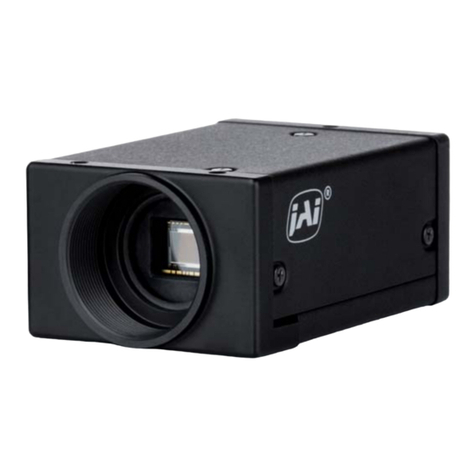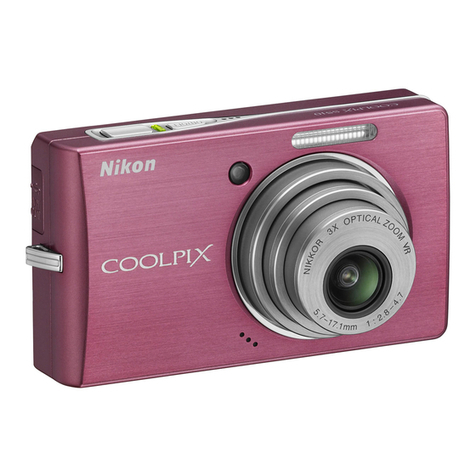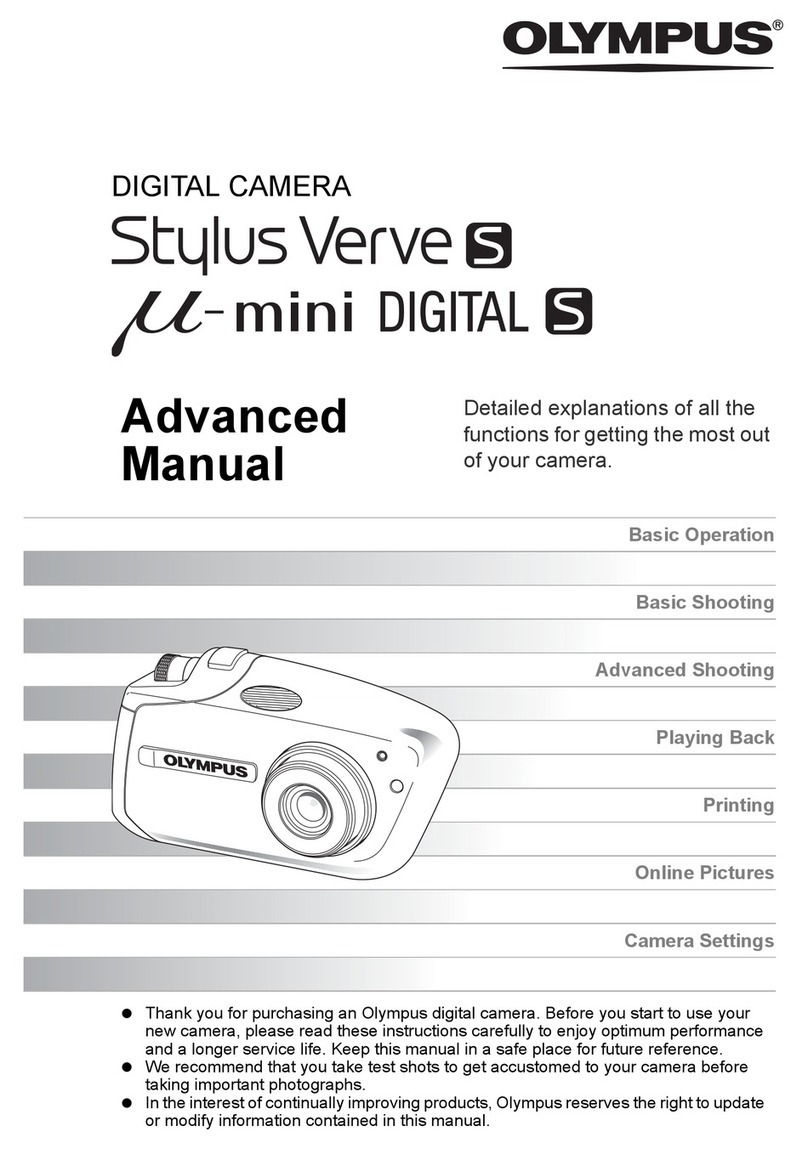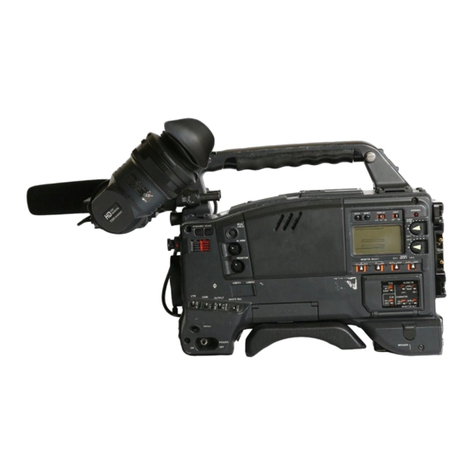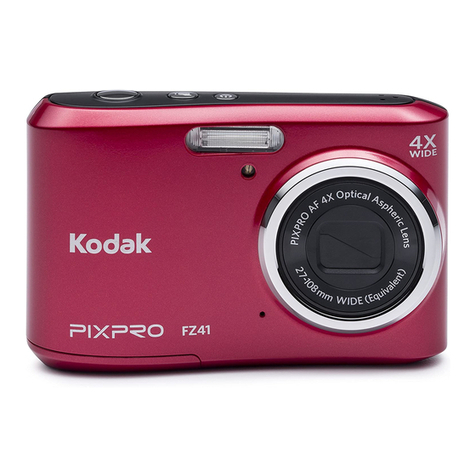Teledyne Photometrics KINETIX User manual

i

ii
58-723-004 Rev A01
© Copyright 2021 Teledyne Photometrics
3440 East Britannia Drive
Tucson, Arizona 85706
Tel: +1 520.889.9933
Fax: +1 520.295.0299
All rights reserved. No part of this publication may be reproduced by any means without the written permission of
Teledyne Photometrics.
Photometrics and PVCAM are registered trademarks of Teledyne Technologies.
Acrobat and Reader are registered trademarks of Adobe Systems Incorporated in the United States and/or other countries.
Intel Core is a trademark of Intel Corporation in the U.S. and/or other countries.
Windows is a registered trademark of Microsoft Corporation in the United States and/or other countries.
All other brand and product names are the trademarks of their respective owners and manufacturers.
The information in this publication is believed to be accurate as of the publication release date. However, Teledyne
Photometrics does not assume any responsibility for any consequences including any damages resulting from the use
thereof. The information contained herein is subject to change without notice. Revision of this publication may be issued to
incorporate such change.
LIMITED WARRANTY
Teledyne Photometrics (“Teledyne Photometrics,” “us,” “we,” “our”) makes the following limited warranties. These limited
warranties extend to the original purchaser (“You,” “you”) only and no other purchaser or transferee. We have complete
control over all warranties and may alter or terminate any or all warranties at any time we deem necessary.
Basic Limited Three (3) Year Warranty
Teledyne Photometrics warrants this product against substantial defects in materials and/or workmanship for a period of
up to three (3) years after shipment. During this period, Teledyne Photometrics will repair the product or, at its sole option,
repair or replace any defective part without charge to you. You must deliver the entire product to the Teledyne
Photometrics factory or, at our option, to a factory-authorized service center. You are responsible for the shipping costs to
return the product. International customers should contact their local Teledyne Photometrics-authorized
representative/distributor for repair information and assistance or visit our technical support page at
www.photometrics.com.

iii
58-723-004 Rev A01
Limited One (1) Year Warranty on Refurbished or Discontinued Products
Teledyne Photometrics warrants, with the exception of the CMOS or CCD image sensor device (which carries NO
WARRANTIES EXPRESS OR IMPLIED) this product against defects in materials or workmanship for a period of up to one (1)
year after shipment. During this period, Teledyne Photometrics will repair or replace, at its sole option, any defective parts,
without charge to you. You must deliver the entire product to the Teledyne Photometrics factory or, at our option, a
factory-authorized service center. You are responsible for the shipping costs to return the product to Teledyne
Photometrics. International customers should contact their local Teledyne Photometrics representative/distributor for
repair information and assistance or visit our technical support page at www.photometrics.com.
Normal Wear Item Disclaimer
Teledyne Photometrics does not warrant certain items against defect due to normal wear and tear. These items include
internal and external shutters, cables, and connectors. These items carry no warranty, expressed or implied.
Software Limited Warranty
Teledyne Photometrics warrants all of our manufactured software discs or memory devices to be free from substantial
defects in materials and/or workmanship under normal use for a period of one (1) year from shipment. Teledyne
Photometrics does not warrant that the function of the software will meet your requirements or that operation will be
uninterrupted or error free. You assume responsibility for selecting the software to achieve your intended results and for
the use and results obtained from the software. In addition, during the one (1) year limited warranty, the original purchaser
is entitled to receive free version upgrades. Version upgrades supplied free of charge will be in the form of a download from
the Internet. Those customers who do not have access to the Internet may obtain the version upgrades on a USB memory
device from our factory for an incidental shipping and handling charge.
Owner’s Manual and Troubleshooting
You should read the owner’s manual thoroughly before operating this product. In the unlikely event that you should
encounter difficulty operating this product, refer to the owner’s manual. If the problem persists, please contact the
Teledyne Photometrics technical support staff or an authorized service representative.
Your Responsibility
The above Limited Warranties are subject to the following terms and conditions:
You must retain your bill of sale (invoice) and present it upon request for service and repairs or provide other proof of
purchase satisfactory to Teledyne Photometrics. You must notify the Teledyne Photometrics factory service center within
thirty (30) days after you have taken delivery of a product or part that you believe to be defective. With the exception of
customers who claim a “technical issue” with the operation of the product or part, all invoices must be paid in full in
accordance with the terms of sale. Failure to pay invoices when due may result in the interruption and/or cancellation of
your limited warranty and/or any other warranty, expressed or implied.
All warranty service must be made by the Teledyne Photometrics factory or, at our option, an authorized service center.
Before products or parts can be returned for service you must contact the Teledyne Photometrics factory and receive a
return authorization number (RMA). Products or parts returned for service without a return authorization evidenced by an
RMA will be sent back freight collect. These warranties are effective only if purchased from the Teledyne Photometrics
factory or one of our authorized manufacturers’ representatives or distributors.

iv
58-723-004 Rev A01
Unless specified in the original purchase agreement, Teledyne Photometrics is not responsible for installation, setup, or
disassembly at the customer’s location.
Warranties extend only to defects in materials or workmanship as limited above and do not extend to any product or part
which has:
•been lost or discarded by you;
•been damaged as a result of misuse, improper installation, faulty or inadequate maintenance, or failure to follow
instructions furnished by us;
•had serial numbers removed, altered, defaced, or rendered illegible;
•been subjected to improper or unauthorized repair; or
•been damaged due to fire, flood, radiation, or other “acts of God” or other contingencies beyond the control of
Teledyne Photometrics.
After the warranty period has expired, you may contact the Teledyne Photometrics factory or a Teledyne Photometrics
authorized representative for repair information and/or extended warranty plans.
Physically damaged units or units that have been modified are not acceptable for repair in or out of warranty and will be
returned as received.
All warranties implied by state law or non-U.S. laws, including the implied warranties of merchantability and fitness for a
particular purpose, are expressly limited to the duration of the limited warranties set forth above. With the exception of
any warranties implied by state law or non-U.S. laws, as hereby limited, the forgoing warranty is exclusive and in lieu of all
other warranties, guarantees, agreements, and similar obligations of manufacturer or seller with respect to the repair or
replacement of any parts. In no event shall Teledyne Photometrics’ liability exceed the cost of the repair or replacement of
the defective product or part.
This limited warranty gives you specific legal rights and you may also have other rights that may vary from state to state and
from country to country. Some states and countries do not allow limitations on how long an implied warranty lasts, when
an action may be brought, or the exclusion or limitation of incidental or consequential damages, so the above provisions
may not apply to you.
When contacting us for technical support or service assistance, please refer to the Teledyne Photometrics factory of
purchase, contact your authorized Teledyne Photometrics representative or reseller, or visit our technical support page at
www.photometrics.com.
U.S. Government Restricted Rights
The software and documentation are provided with Restricted Rights. Use, duplication, or disclosure by the Government is
subject to restrictions as set forth in subparagraph (c)(1)(ii) of the Rights in Technical Data and Computer Software clause at
DFARS 252.227-7013 or subparagraphs (c)(1) and (2) of the Commercial Computer Software-Restricted Rights at 48 CFR
52.227-19, as applicable. Contractor/manufacturer is Teledyne Photometrics, 3440 East Britannia Drive, Tucson, AZ 85706.
This license is effective until terminated. It will terminate upon the conditions set forth above or if you fail to comply with
any term hereof. Upon termination, you agree that the software and accompanying materials, and all copies thereof, will be
destroyed. This agreement is governed by the laws of the State of Arizona. You acknowledge that you have read this
agreement, you understand it, you agree to be bound by its terms, and that this is the complete and exclusive statement of
the agreement between you and Teledyne Photometrics regarding the software.

v
58-723-004 Rev A01

vi
58-723-004 Rev A01

vii
58-723-004 Rev A01
Table of Contents
LIMITED WARRANTY ................................................................................................................................................................ii
Basic Limited Three (3) Year Warranty ....................................................................................................................................ii
Limited One (1) Year Warranty on Refurbished or Discontinued Products............................................................................ iii
Normal Wear Item Disclaimer ................................................................................................................................................ iii
Software Limited Warranty .................................................................................................................................................... iii
Owner’s Manual and Troubleshooting ................................................................................................................................... iii
Your Responsibility ................................................................................................................................................................. iii
U.S. Government Restricted Rights ........................................................................................................................................ iv
Table of Contents .............................................................................................................................................................. vii
Chapter 1 – Overview ..........................................................................................................................................................1
About This Manual...................................................................................................................................................................1
Precautions ..............................................................................................................................................................................1
Environmental Requirements..................................................................................................................................................2
Storage Requirements .............................................................................................................................................................2
Microscopes, Lenses, and Tripods ...........................................................................................................................................2
Repairs .....................................................................................................................................................................................2
Cleaning ...................................................................................................................................................................................2
Chapter 2 – System Installation ...........................................................................................................................................3
Introduction.............................................................................................................................................................................3
Getting to Know Kinetix ...........................................................................................................................................................4
Software Compatibility Requirements.....................................................................................................................................4
Host Computer Requirements .................................................................................................................................................4
Software Installation................................................................................................................................................................5
Installing the PCI Express Interface Card .................................................................................................................................5
Connecting Kinetix to PCI Express Bus.....................................................................................................................................8
Connecting Kinetix with USB..................................................................................................................................................10
Chapter 3 – Theory of Operation .......................................................................................................................................11
Introduction...........................................................................................................................................................................11
CMOS Image Sensor Structure...............................................................................................................................................11
Gain Combining and Bit Depth ..............................................................................................................................................12
Rolling and Global Shutter Readout.......................................................................................................................................12

viii
58-723-004 Rev A01
Digital Binning........................................................................................................................................................................14
Sensor Clearing ......................................................................................................................................................................14
Bias Offset Settings ................................................................................................................................................................14
Pixel Noise Filters...................................................................................................................................................................15
Chapter 4 – Operating Features.........................................................................................................................................18
Introduction...........................................................................................................................................................................18
Modes and Gain States ..........................................................................................................................................................18
Clearing Mode........................................................................................................................................................................18
Regions of Interest.................................................................................................................................................................19
Programmable Scan Mode ....................................................................................................................................................19
Auto ...................................................................................................................................................................................20
Line Delay...........................................................................................................................................................................20
Scan Width.........................................................................................................................................................................21
Scan Direction ....................................................................................................................................................................21
Device Synchronization (Triggering) ......................................................................................................................................22
Trigger Modes........................................................................................................................................................................23
Internal Mode ....................................................................................................................................................................23
Trigger-First Mode .............................................................................................................................................................23
Edge Mode.........................................................................................................................................................................23
Level Trigger Mode ............................................................................................................................................................23
Level Trigger Overlap Mode...............................................................................................................................................23
Usage Summary of Level Trigger Modes ...........................................................................................................................24
Software Trigger Edge........................................................................................................................................................24
Software Trigger-First ........................................................................................................................................................24
Expose Out Modes.................................................................................................................................................................24
First Row Mode..................................................................................................................................................................25
All Rows Mode ...................................................................................................................................................................25
Rolling Shutter Mode.........................................................................................................................................................25
Line Output Mode..............................................................................................................................................................26
Any Row Mode...................................................................................................................................................................26
Multiple Output Triggers .......................................................................................................................................................26
SMART Streaming ..................................................................................................................................................................27
Fan Speed Control..................................................................................................................................................................27
Time Stamps ..........................................................................................................................................................................28

ix
58-723-004 Rev A01
Chapter 5 – Troubleshooting .............................................................................................................................................29
Difficulty Installing PCIe Cables..............................................................................................................................................29
System Does Not Boot Normally ...........................................................................................................................................29
New Hardware Found Dialog Box Does Not Appear..............................................................................................................30
Images Not Displayed ............................................................................................................................................................30
Camera Running Too Warm...................................................................................................................................................30
PVCAM Error Message Appears.............................................................................................................................................31
Lengthy Pauses During Imaging.............................................................................................................................................31
Chapter 6 – Basic Specifications.........................................................................................................................................32
Kinetix Dimensional Drawings ...............................................................................................................................................32
Camera Weight ......................................................................................................................................................................32
Sensor Specifications .............................................................................................................................................................33
Power Supply Specifications ..................................................................................................................................................33
Appendix A – Liquid Cooling Setup Instructions................................................................................................................. 34
Appendix B – Hotswap/Hotplug Capability........................................................................................................................ 35
Appendix C – Multi-Camera Configuration ........................................................................................................................36

1
58-723-004 Rev A01
Chapter 1 – Overview
About This
Manual
The Kinetix Scientific CMOS Camera User Manual is divided into six chapters and three
appendices. Teledyne Photometrics recommends you read the entire manual before
operating Kinetix to ensure proper use. The chapters that follow the Overview are
briefly described below.
Note: The information in these chapters applies only to the Kinetix camera and is
currently not applicable to any other Teledyne Photometrics camera.
•System Installation – Instructions for connecting the Kinetix camera to a
computer via the PCI Express interface card or the USB 3.2 interface.
•Theory of Operation – A basic overview of Scientific CMOS camera technology
as used in the Kinetix camera.
•Operating Features – Kinetix features and how to optimize them for
sensitivity, speed, dynamic range; how to use the different trigger modes.
•Troubleshooting – Answers to common camera system questions.
•Basic Specifications – Specifications for Kinetix system components.
Precautions
The CMOS sensor and other system electronics are extremely sensitive to electrostatic
discharge (ESD). To avoid permanently damaging the system, please observe the
following precautions:
•If using high-voltage equipment (such as an arc lamp) with the camera system,
turn the camera power on last and when powering down, power the camera
off first.
•Never connect or disconnect any cable while the system is powered on.
•The camera’s power should be switched off before disconnecting any camera
system cables. However, it is not necessary to power off the computer to
detach the cables.
•Use caution when triggering high-current switching devices (such as an arc
lamp) near the system. The image sensor can be permanently damaged by
transient voltage spikes. If electrically noisy devices are present, an isolated,
conditioned power line or dedicated isolation transformer is highly
recommended.
•Always leave one inch of space around the camera for airflow.
•Do not operate the camera without cooling (air or liquid).
•Never open the camera. There are no user-serviceable parts inside the Kinetix
camera. Opening the camera voids the warranty.

2
58-723-004 Rev A01
•Use only the PCI Express interface card, cables, and power supply designated
for this camera system. Using non-Kinetix cables, PCI Express interface cards,
or power supplies may result in unexpected errors or permanent damage to
the system.
•Do not use a C-mount lens with optics that extend behind the lens flange.
Environmental
Requirements
The Kinetix camera system should be operated in a clean, dry environment. The camera
system’s ambient operating temperature is 0°C to 30°C with 80% relative humidity,
non-condensing.
Storage
Requirements
Store the Kinetix camera system in its original containers. To protect the system from
excessive heat, cold and moisture, store at an ambient temperature between -20°C and
60°C with a relative humidity of 0% to 90%, noncondensing.
Microscopes,
Lenses, and
Tripods
The camera has standard threaded adapter mounts and can be mounted to any
microscope that accepts a standard C-mount adapter, F-mount adapter, or a T-mount
adapter. The camera also allows you to install any lens that is compatible with the
standard threaded mounts as long as its optics do not extend behind the flange of the
adapter. Kinetix can be mounted to optical tables, tripods, and copy stands using the
eight ¼-20 threaded attachment points located near the camera front on all sides. A
crosshair indicates the location of the sensor for optical alignment purposes.
Repairs
Please save the original packing materials so you can safely ship the camera to another
location or return it for repairs if necessary. The Kinetix camera system contains no
user-serviceable parts. Repairs must be done by Teledyne Photometrics. Should the
camera system require repairs, please contact Teledyne Photometrics Customer
Service.
Note: Do not open the camera. Opening the Kinetix camera voids the warranty.
Cleaning
Clean exterior surfaces of the camera with a dry, lint-free cloth. To remove stains,
contact Teledyne Photometrics Customer Service. To clean the camera’s imaging
window, use only a filtered compressed-air source. Hand-held cans are not
recommended as they may spray propellant onto the window. Do not touch the
window.

3
58-723-004 Rev A01
Chapter 2 – System Installation
Note: Carefully review the Precautions section in the previous chapter before performing
any of the procedures outlined in this chapter. Again, use only a Kinetix PCI Express data
cable and Kinetix PCI Express interface card with the camera. Using a different cable or
interface card may result in unexpected errors or permanent damage to the system.
Introduction
The Kinetix camera system includes the following hardware components:
•
Kinetix Scientific CMOS Camera
•
USB 3.2 A to C data cable, 1 m
•
USB 3.2 C to C data cable, 3 m
•
A 12V/10A DC power supply with international power cord set
•
I/O to 8 BNC trigger breakout cable, part number CBL-IO-8-BNC
•
USB memory device containing PVCAM library and drivers
•
Quick Installation Guide
•
PCI Express (PCIe) interface card
•
PCI Express data cables (two identical cables)
•
USB 3.2 10 Gbps interface card
•
C-mount front plate
•
F-mount front plate
•
T-mount front plate
Kinetix system components are linked by two PCI Express data cables or a USB 3.2 data
cable and controlled by the host computer system. These hardware components should be
included with the shipment. Keep all the original packing materials so you can safely ship
the camera to another location or return it for service.
If you have any difficulty with any step of the instructions, contact Teledyne Photometrics
Customer Service.

4
58-723-004 Rev A01
Getting to
Know Kinetix
Highlights of the Kinetix camera are shown below. The Kinetix package includes the PVCAM
drivers designed to allow you to use this camera with a variety of third-party imaging
software. For a list of supported software, visit the Teledyne Photometrics website.
•USB 3.2 10 Gbps Data Connection
•PCI-E: High Speed Connection
•In/Out: Liquid Cooling Connections
•Initializing: LED blinking indicates the camera is booting up
•Power Switch: Turns the camera on and off
•Trigger: Hirose HR10A-10R-10S for use with Teledyne Photometrics trigger to
BNC breakout cable CBL-IO-8-BNC
•Power in: Connection to external 12V/10A DC power supply
Software
Compatibility
Requirements
Unless there is a preferred version specified by a third-party software provider, the latest
version of PVCAM is recommended for use with Kinetix:
https://www.photometrics.com/support/download/pvcam.
Host Computer
Requirements
The host computer (PC) for Kinetix must meet the following minimum requirements:
•Windows 10 64-bit operating system
•3.0 GHz or faster Intel processor: either Xeon or Core i7; 4 or more
cores

5
58-723-004 Rev A01
•16+ GB DDR3 RAM or higher (Teledyne Photometrics recommends
matching the number of memory modules with the number of CPU-
supported memory channels)
•256 GB or larger serial ATA (SATA) SSD for the operating system
•1 GB slot-based ATI/NVIDIA video graphics card
•Internet access to obtain the PVCAM library and interface drivers
•USB 3.2 or Thunderbolt port for use with the USB 3.2 interface
•An open PCI Express 8x Gen 3 interface slot or higher for use with the
PCIe interface card
Note: To achieve optimal performance, see our latest recommended PC specifications at
https://www.photometrics.com/support/recommended-pc-specifications.
Software
Installation
An appropriate Quick Installation Guide is included as an insert with the Kinetix camera.
This guide provides step-by-step instructions for installing the camera interface software
for Windows-based computers. Additional instructions are included for installing a PCI
Express interface card in the computer.
The Teledyne Photometrics USB memory device contains the following files:
•Manuals Directory — contains user manuals in PDF format
•Customer Case Studies — application examples
•Imaging Software – a copy of the Free Open Source Software Application, Micro-
Manager
•Technical Notes – detailed background on advanced features
•For a 64-bit Windows OS, install the PVCAM driver
•Follow the Quick Installation Guide insert for the version of Windows being used
and then reboot the computer when the installation is complete
Installing the
PCI Express
Interface Card
As CMOS cameras have developed, the amount of data generated from these products has
exceeded the current capabilities of USB interfaces. The Kinetix CMOS camera platform
provides both USB 3.2 for convenience and a PCI Express interface to ensure that the
interface is capable of sustaining the required bandwidth of the camera.
Instructions for Installing the High Speed PCI Express Interface Card:

6
58-723-004 Rev A01
Note: The model of PCIe card shipped with the camera may differ from the one shown in
the photo.
Before attempting to operate the camera, first install this interface card into the PC via the
following steps:
1. Shut down the PC.
2. Unplug the PC from power mains and ensure the camera is turned off.
3. Open the side of the computer to access the PCI and PCIe slots.

7
58-723-004 Rev A01
4. Locate an available 8-channel or higher PCIe slot (marked x8). Refer to the
PC’s documentation to locate a suitable slot.
User Tip: The PC may have motherboard slot information on the side cover.
5. Hold the PCIe card (being careful not to touch the board components or PCIe
bridge pins) and insert it, properly orientated, into the open slot. The card
should slide into place with minimal resistance and click when fully inserted.
PCIe card inserted into a 16-channel PCIe slot.
PCIe card inserted into an 8-channel PCIe slot. Note the remaining free-floating PCIe slots.

8
58-723-004 Rev A01
The default DIP Switch pin settings for the PCIe card are shown below. This will allow the
user to run one or two cameras off the PCIe card at the full speeds available.
Connecting
Kinetix to PCI
Express Bus
The two Kinetix camera data cables are identical, quick-insertion, quick-release cables that
connect the interface card and the camera. One of these cables is shown below.
Note: The PCIe data cables’ connectors can only be inserted into the PCIe ports when
correctly oriented; do not force the connectors. If a connector does not insert, simply turn
the connector over and retry.
To ensure proper system performance, one of the cables should be used to connect the
camera’s PCIe port 1 to the PCIe interface card’s port 1. (Either end of the cable can be
plugged into either device.) The other cable should be used to connect the camera’s PCIe
port 2 to the PCIe interface card’s port 2. (Again, either end of the cable can be plugged
into either device.) See the following two figures. Here, both ends of one cable have been
wrapped with white tape to differentiate it from the other cable.
PCIe cables inserted into camera’s PCIe ports.

9
58-723-004 Rev A01
PCIe cables inserted into PCIe interface card’s ports.
User Tip: To avoid any future confusion, add a marker of some sort, like electrical tape, to
each end of one cable during camera installation and then confirm that port 1 on the
camera is connected to port 1 on the PCIe card, and that port 2 on the camera is
connected to port 2 on the PCIe card.
With the PCIe data cables properly connected, it is time to power on the computer:
1. Verify that the power switch on the side of the camera is in the off position.
2. Connect the power supply to the Power connector on the rear of the camera.
3. Plug the power cord into the power supply and then into a suitable wall
outlet.
4. Power on the computer and let it go through its normal startup procedure.
5. Turn on Kinetix and allow it 30 seconds to boot before starting software.
For Kinetix builds June 25, 2021 (or later), camera serial numbers A21F723001 (or greater),
it is no longer necessary to turn the camera on before powering up the computer. Kinetix
can be turned on after the computer starts up and power cycled while the computer
remains on. See Appendix B for details.
User Tip: The power supply and connector used by the Kinetix camera are each a
common type. However, Teledyne Photometrics carefully selects power supplies for
optimum noise performance, EMI compliance, and stability. Do not swap power supplies
with other lab equipment even though they may meet the connector, voltage, and
ampere requirements of Kinetix.
Verify the camera link has been established, which is confirmed by two green LED lights on
the PCIe card.

10
58-723-004 Rev A01
If one or both LEDs are orange instead of green, make sure the cables are connected in
the right ports order and are undamaged.
Connecting
Kinetix with
USB
The Kinetix camera’s USB 3.2 10 Gbps interface (formally known as USB 3.1 Gen 2) is
ubiquitous and easy to use. To use the interface, the PC must have an open USB 3.2 or
Thunderbolt port.
User Tip: USB devices sharing the same bus as Kinetix contend for available bandwidth,
potentially causing the camera to drop frame rate. For this reason, Teledyne
Photometrics recommends isolating the camera to its own USB 3.2 root hub as shown in
the Windows Device Manager. A method for creating an independent root hub in
computers with many USB devices is to install a PCI Express-based USB 3.2 interface card
for use with the camera. We do not recommend connecting Kinetix to USB 3.0.
You are now ready to connect the USB 3.2 cable:
1. With the camera off, connect the USB 3.2 cable to the camera and host
computer.
2. Power the camera on.
3. Wait 30 seconds before launching the application. An LED on the back of the
camera will stop blinking when the camera is initialized and ready to
communicate.

11
58-723-004 Rev A01
Chapter 3 – Theory of Operation
Introduction
Backside-illuminated scientific CMOS (BSI Scientific CMOS) sensors are a recent but rapidly
maturing development in image sensor technology. Boasting near-perfect 95% quantum
efficiency (QE), they are able to provide the highest levels of sensitivity. New cameras can
now leverage these high-QE sensors to offer a combination of low read noise, high full well
capacity, and fast readout rates that is ideal for modern low-light imaging.
CMOS Image
Sensor
Structure
A major difference between traditional CCD sensors and CMOS sensors is the location where
charge-to-voltage conversion of accumulated photoelectrons takes place.
CCD sensors transfer the pixels’ accumulated signal in charge packets in “bucket brigade”
fashion across the sensor to a common output node where charge is converted to a voltage.
The voltage is then sampled using off-chip analog-to-digital converters (ADCs) and
transferred to the PC as digital grey values.
While providing excellent quantitative photometry and very high image quality, the large
number of transfers and sequential digitization of pixels results in low frame rates. This
speed penalty increases with the number of pixels to be digitized.
CMOS sensors leverage many of the same analog signal concepts used in CCDs but place
the output node circuitry inside each pixel. This eliminates the charge transfer process.
To read the signal from a given row, the accumulated charge is converted to a voltage
inside the pixel, then each pixel in the row is connected to the appropriate column
voltage bus, where the on-chip ADCs convert the voltages to a grey value.
The parallel digitization of all pixels in a row provides CMOS devices with a tremendous
speed advantage. Imagine a CCD with 3200 x 3200 pixels – and each pixel’s voltage is
measured in 1 µsec. To read a single row, 3200 voltage measurements are performed in
serial fashion taking slightly longer than 3.2 msec, and when repeated for 3200 rows, the
entire image takes more than 10 seconds to be digitized.
On a CMOS device, the entire 3200 voltage conversions needed to digitize a row happen in
parallel. If the time to digitize a pixel remains at 1 µsec, the time to read the entire frame is
now 3.2 msec. In practice, the time saving is split between faster frame rates and slowing
the rate of pixel measurement to reduce electronic noise. For example, if the time to
measure a pixel was increased to 3.749 µsec to reduce noise, then the image sensor can
still be read in 12 msec (for a maximum 83 fps).
Table of contents
Other Teledyne Photometrics Digital Camera manuals
Popular Digital Camera manuals by other brands
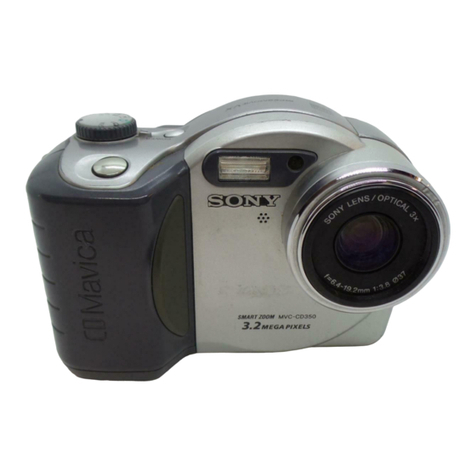
Sony
Sony MVC-CD350 - Digital Still Camera Mavica Cd... operating instructions
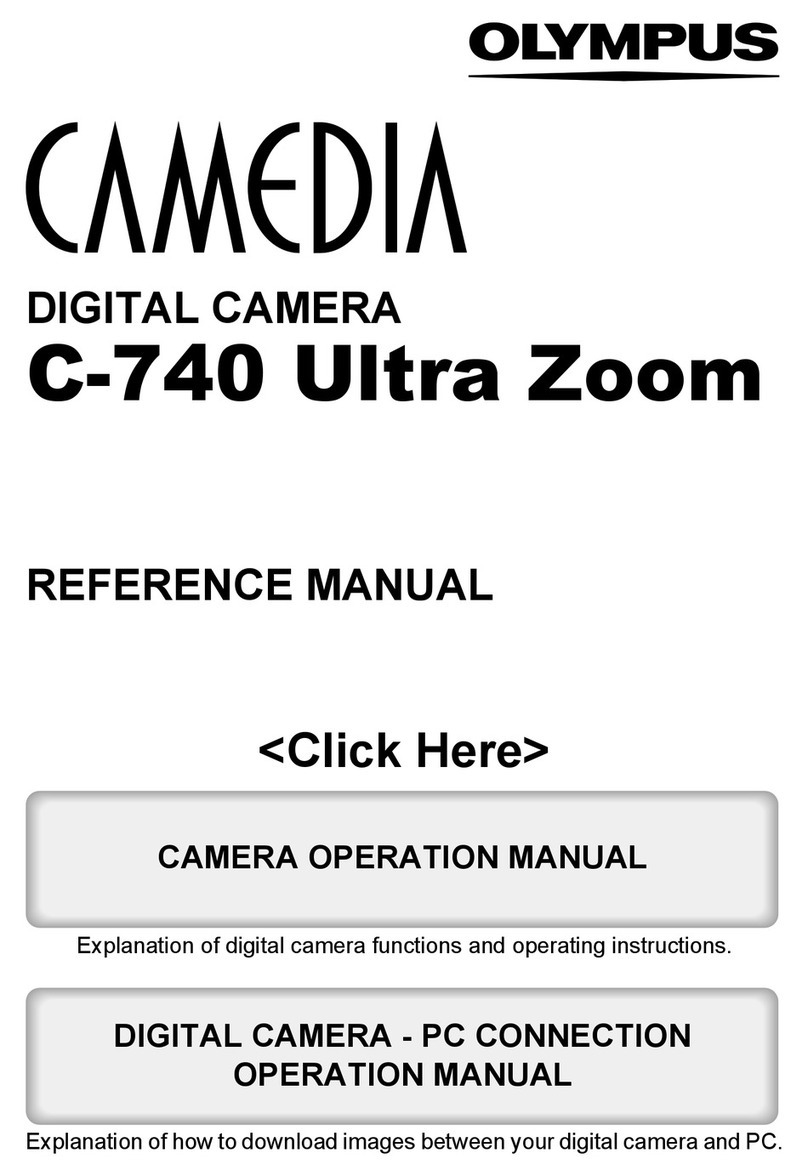
Olympus
Olympus CAMEDIA C-740 Ultra Zoom Reference manual
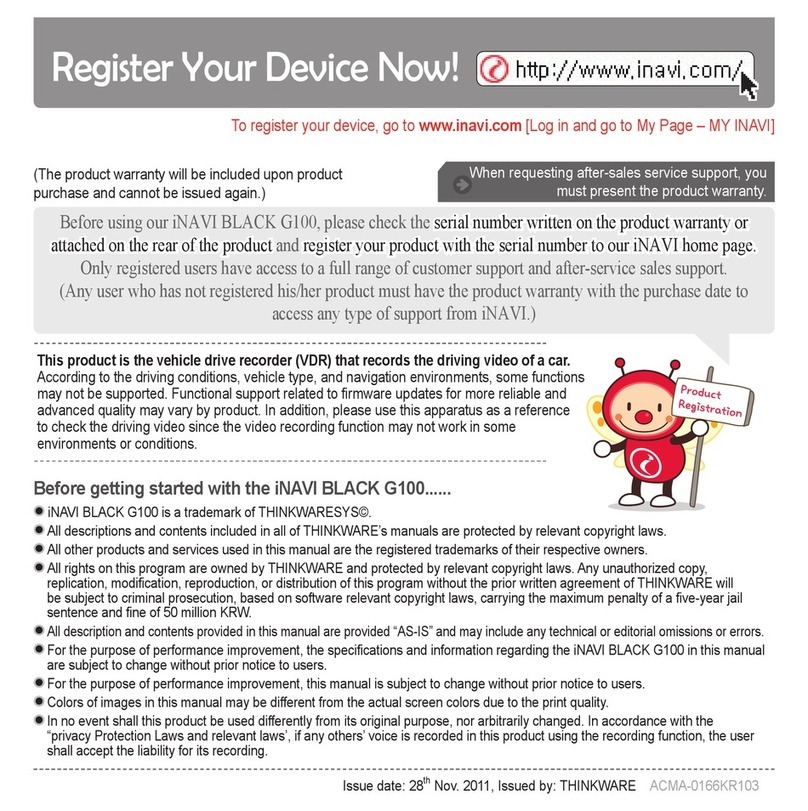
Thinkware
Thinkware iNAVI BLACK G100 user manual
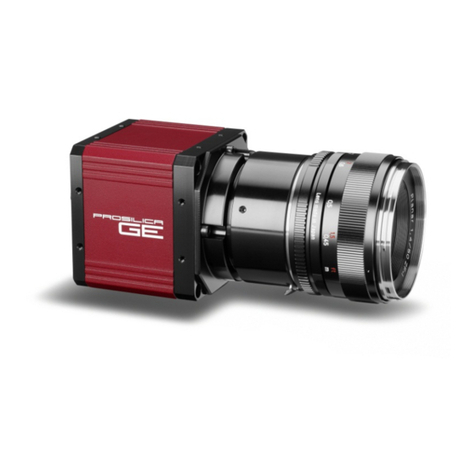
Allied
Allied AVT Prosilica GE Technical manual
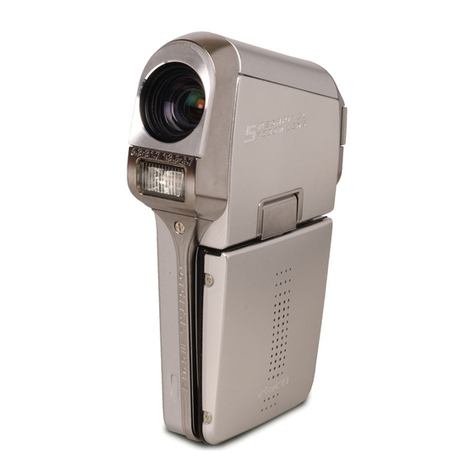
Sanyo
Sanyo Xacti VPC-C5 instruction manual

Ricoh
Ricoh Caplio 500SE Brochure & specs
